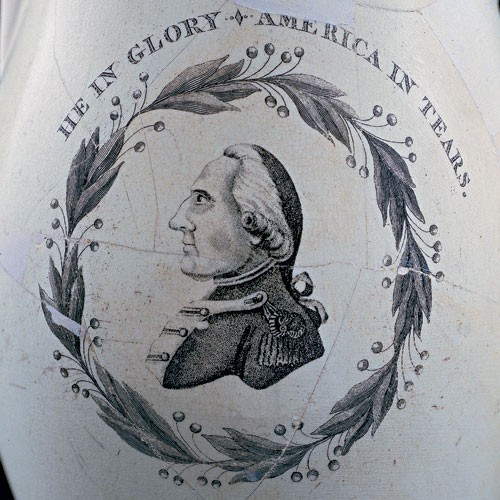
Detail of the pitcher illustrated in fig. 9. (Unless otherwise noted, all objects are from the collection of the Alexandria Archaeology Museum; unless otherwise noted, all photos by Gavin Ashworth.) This George Washington cartouche adorns a creamware mourning pitcher that was recovered from an archaeological site in Alexandria.
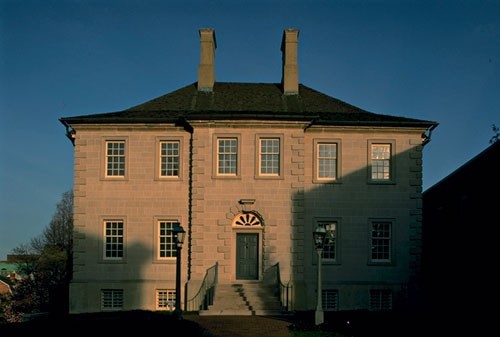
The Carlyle House, 121 North Fairfax Street, Alexandria, Virginia. (Courtesy, Office of Historic Alexandria; photo, Eric Kvalsvik.) Now a museum operated by the Northern Virginia Park Authority, Braddock headquartered here in 1755.
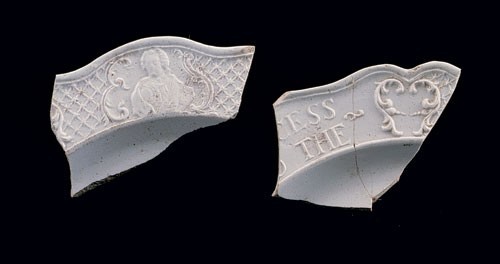
Plate fragments, England, ca. 1758. White salt-glazed stoneware. D. 9". The plate bore a bust of Frederick the Great and the slogan “SUCCESS TO THE KING OF PRUSSIA.” Beginning in 1758 the British supported Prussia against the Austrians and their French allies. This plate was owned by a family residing at 418 King Street, one block from the Carlyle House, and its fragments were discarded in a privy.

Pitcher fragment, England, ca. 1770s. Creamware. The scene depicts the death of General Wolfe, who successfully led British forces against the city of Quebec in 1759, during the French and Indian War.
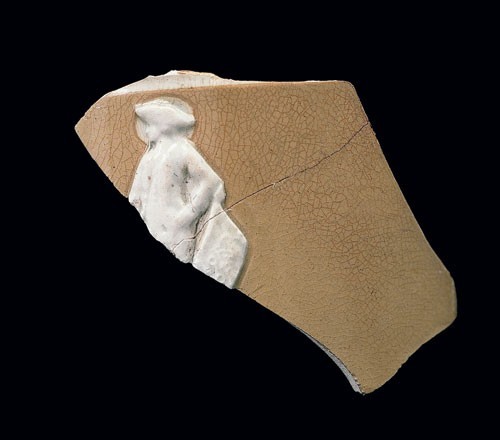
Tankard fragment, England, ca. 1782. Banded creamware with relief-molded appliqué of Lord Rodney. This fragment and others, discarded about 1790, were found at the bottom of a brick shaft at 109 South Fairfax Street, Alexandria, Virginia.

Replica of George Washington’s town house. (Courtesy, Office of Historic Alexandria; photo, Eric Kvalsvik.) Washington’s town house at 508 Cameron Street was built by 1769 and demolished in 1857. This replica was constructed on the same site in 1960. The Alexandria Gazette (June 7, 1851) described the original house as “a small frame house, the ascent to which is by a long narrow flight of steps. How simple the habits, how unostentatious the movements and the mansion of the deliverer of his country. . . . A stranger might pass and re-pass this house many times without taking any notice of it.” Although the house was often rented or lent to friends and family, Washington is thought to have spent some nights there in the early 1770s, and his letters give detailed orders for fencing the property, painting, and other repairs.
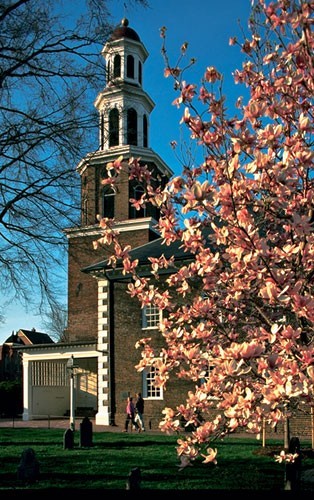
Christ Church, 118 North Washington Street, Alexandria, Virginia. (Courtesy, Office of Historic Alexandria; photo, Eric Kvalsvik.) George Washington’s family pew is preserved here. The church was constructed in 1773; the bell tower was added in 1818.

The ballroom at Gadsby’s Tavern Museum, 134 North Royal Street, Alexandria, Virginia. (Photo, Louise Krafft.) George and Martha Washington danced here at his Birthnight Balls in 1797 and 1798. The celebratory balls continued to be held long after his death, until the Civil War. Reenactments of the ball were held in 1932, on the bicentennial of Washington’s birth, and sporadically until the bicentennial of the nation, when the ball once again became an annual event.
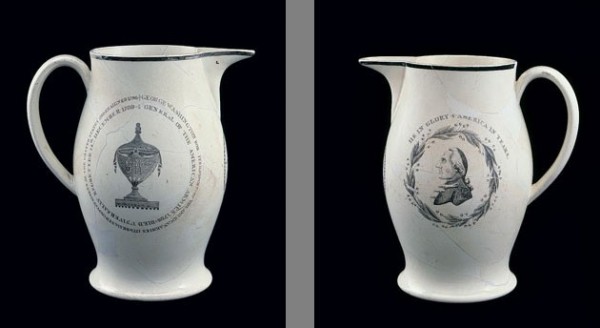
Pitcher, attributed to the Herculaneum Pottery, Liverpool, ca. 1800. Creamware. H. 8 1/2". This black-rimmed mourning pitcher depicts Washington in profile surrounded by a wreath, with the words “HE IN GLORY· AMERICA IN TEARS.” On the reverse is an urn with the initials GW and the words “GEORGE WASHINGTON BORN FEB. 11, 1732 / GEN’L OF THE AMERICAN ARMIES 1775 / RESIGNED 1785 / PRESIDENT OF THE UNITED STATES 1789 / RESIGNED 1796 / GENERAL OF THE AMERICAN ARMIES 1798 / DIED UNIVERSALLY REGRETTED 14TH DECEMBER 1799.” Underneath the spout are the words “A MAN WITHOUT EXAMPLE / A PATRIOT WITHOUT REPROACH.”
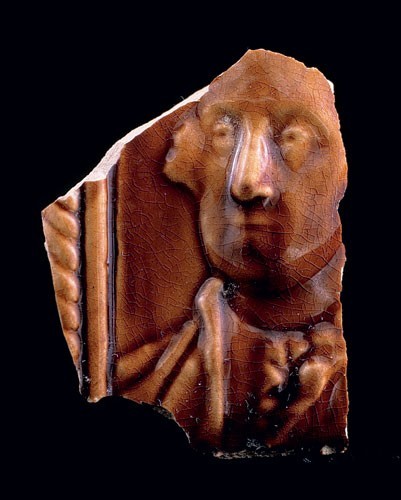
Teapot or pitcher fragment, United States, after 1845. Rockingham pottery. This sherd depicting George Washington was found during excavations at a home at 809 Duke Street, Alexandria, Virginia.

Bust of George Washington, Wedgwood, Staffordshire, 1875. Basalt stoneware. H. 18 1/4” (Courtesy, The Lyceum: Alexandria’s History Museum.) Inside the base are the letters xcd. This large bust was made in time to celebrate the nation’s centennial.
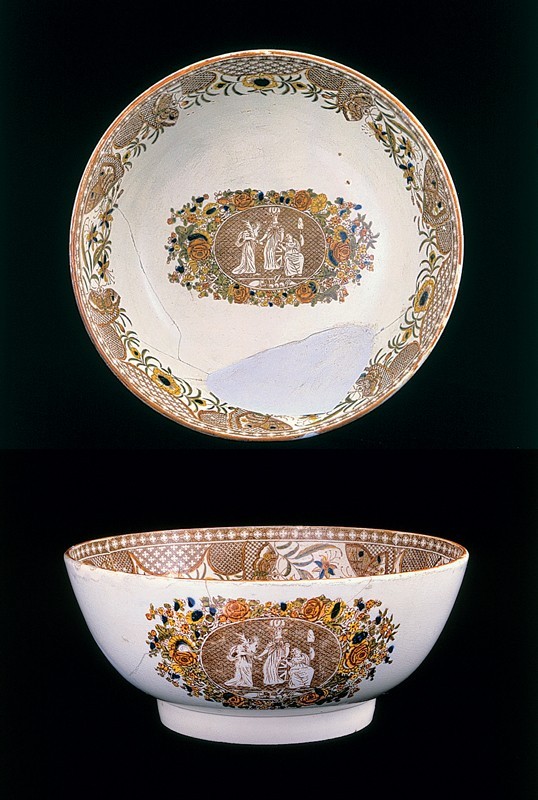
Punch bowl, England, ca. 1802. Pearlware. D. 10 1/4". Britannia is pictured with her shield. To her left is Victory, holding a palm frond, and seated to her right is France holding the Liberty Cap. The border includes a lovely butterfly motif. This punch bowl, made in celebration of the Treaty of Amiens, is from the household of Samuel Snowden, editor of the Alexandria Gazette. It was discarded in the 1820s, in a privy behind his home and office at 105 South Royal Street.

Cup and saucer, England, ca. 1802. Pearlware. D. of cup 3 5/8"; D. of saucer 5 1/2". Cups and saucers depicting Britannia came from the household of one of Snowden’s neighbors, on the 400 block of King Street.

Cup and saucer, England, ca. 1802. Pearlware. D. of cup 4"; D. of saucer 5". Cups, saucers, a cream pitcher, and a slop bowl from this tea set were found at the site of McKnight’s Tavern, at the corner of King and Royal Streets.
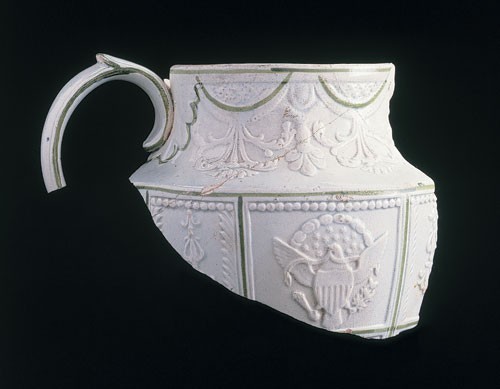
Pitcher fragment, attributed to Sowter and Company, Mexborough, Yorkshire, ca. 1800–1807. Castleford-style white feldspathic stoneware. This pitcher fragment, which bears the Great Seal of the United States, was found behind a house at 113 South Royal Street, Alexandria. It may have been discarded by the owner of McKnight’s Tavern, William H. McKnight, who moved there in 1816. The pitcher has the same molded relief pattern as a black stoneware teapot attributed to Sowter and Company.
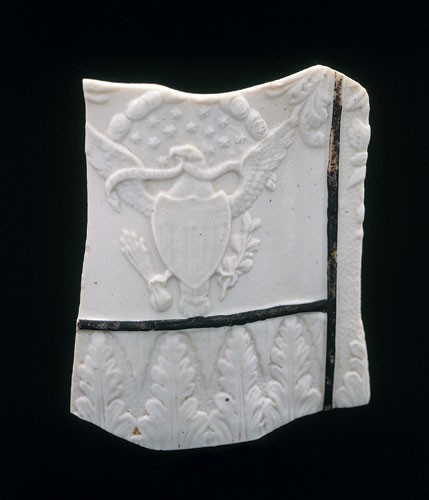
Pitcher fragment, attributed to the Leeds Pottery, ca. 1805-1807. Pearlware. The enameled lines that separate panels with molded relief decoration of the Great Seal are in the style of the Castleford Pottery, but the molded border on the pannels is identical to a Leeds sucrier in feldspathic stoneware. This fragment was found in a well behin the workshop of James Green, cabinetmaker, which stood in the interior of the square bounded by Fairdax, Prince, Royal, and King Streets and near the intersection of Royal and King Streets. The sherd was in a deposit relating to a fire in 1823 but probably had reached Alexandria before the Embargo of 1807.
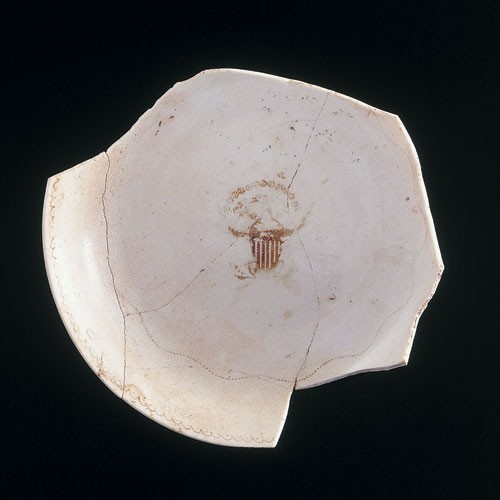
Saucer, England, possibly Enoch Wood and Sons, ca. 1784–1792. Soft-paste porcelain. D. 6". The Great Seal, with the motto “E PLURIBUS UNUM,” appears on this saucer, which was found in a well associated with Gadsby’s Tavern at 134 North Royal Street.
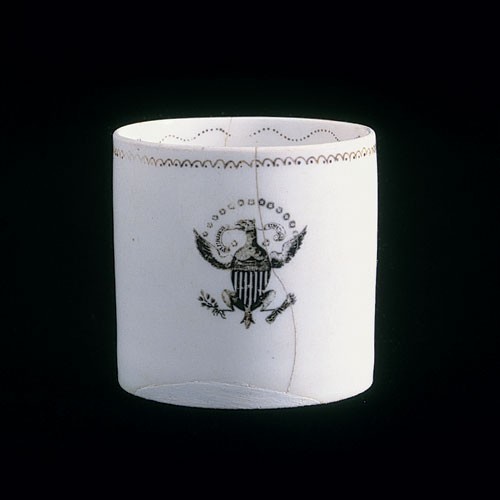
Coffee can, England, ca. 1795–1807. Bone china. H. 2 1/2". This cup, depicting the Great Seal, was found behind the James Green cabinet shop along with the Castleford-style pearlware sherd illustrated in fig. 16.
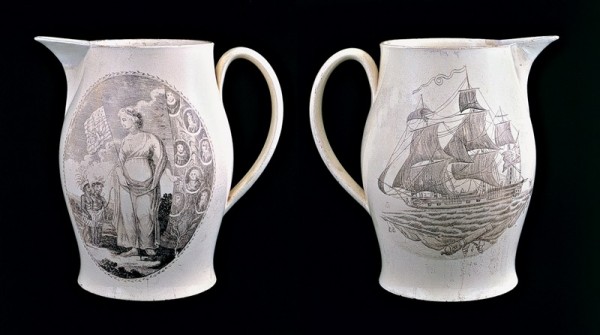
Pitcher, attributed to the Herculaneum Pottery, Liverpool, ca. 1800. Creamware. H. 8 1/2". In this reproduction of An Emblem of America, first published in 1799, a central figure holds an American flag. At left are two Indians and at right are portrait medallions of Christopher Columbus, Americus, Sir Walter Raleigh, Benjamin Franklin, George Washington, John Adams, and one unidentified person. On the reverse is a ship and cannon. Samuel Snowden, editor of the Alexandria Gazette, owned this patriotic piece.
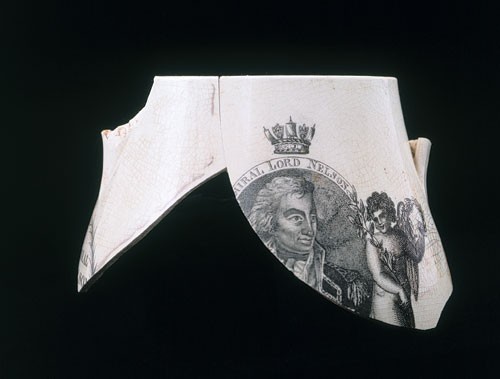
Mourning pitcher fragment, England, ca. 1805. Creamware. Found at the site of Arell’s Tavern, this pitcher has the words “ADMIRAL LORD NELSON” on a wreath cartouche below the spout. On one side is a portrait of Nelson flanked by cherubs. The missing portion shows a plan of the Battle of the Nile beneath the portrait. On the reverse are more cherubs within a wreath border. Nelson died tragically at Trafalgar as his troops defeated Napoleon.

Creamer, England, ca. 1815. Basalt stoneware with glazed interior. L. 5 3/4". Tools of war appear on one side of this creamer; on the other side, inscribed above the figure of Wellington on horseback, are the words “VENI VIDI VICI.” This famous Latin phrase complements the creamer’s neoclassical form.
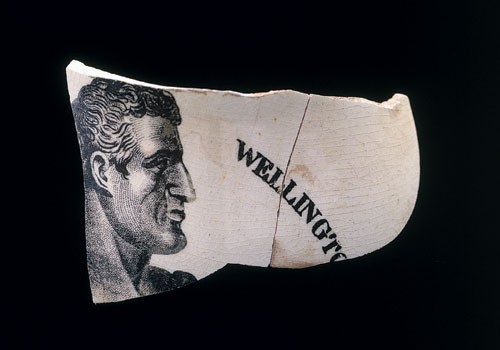
Pitcher fragment, England, ca. 1815. Creamware. This pitcher celebrates Wellington’s defeat of Napoleon at Waterloo, which ended twenty-three years of war between Britain and France.
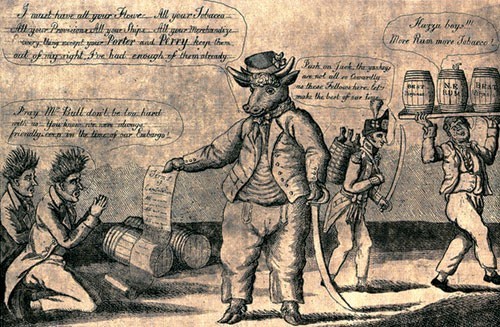
Johnny Bull and the Alexandrians, William Charles, 1814. Etching and aquatint. Sheet 9 3/4" x 13 1/2". (Courtesy, The Lyceum: Alexandria’s History Museum.) Alexandrians are shown cowering and pleading with Johnny Bull, a symbol for England. The cartoon ridicules Alexandria’s 1814 surrender to the British in the War of 1812. The Alexandrians plead: “Pray Mr. Bull don’t be too hard with us—You know we were always friendly, even in the time of our Embargo!” Their words suggest that British goods might have reached the port of Alexandria during the embargo years.
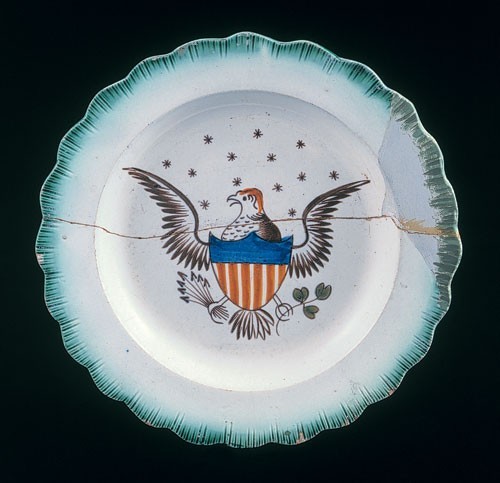
Plate, England, ca. 1815–1830. Pearlware. D. 7". The even scallop rim dates from ca. 1810–1835. Because of the limited palette of colors available for underglaze pearlware decoration, the shield is painted in orange and blue enamels. A set of these plates, marked with an impressed “B,” was found at Arell’s Tavern. An 8" blue shell-edged eagle plate was found at McKnight’s Tavern, whose location was marked by the shop’s sign, a spread eagle.
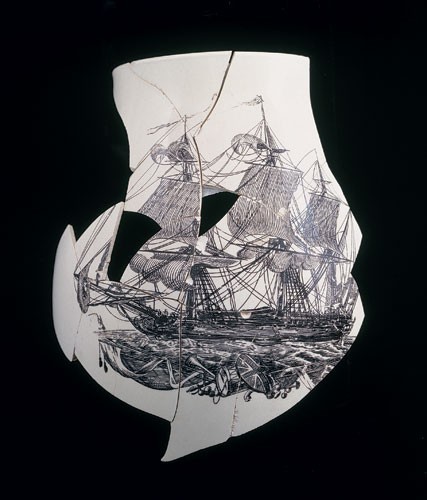
Pitcher fragment, England, ca. 1815. Creamware. This fragment, found at the site of McKnight’s Tavern, displays a merchant ship. The ship motif was common on creamware pitchers when the War of 1812 ended and trade was restored. It was often used in conjunction with commemorative patterns.
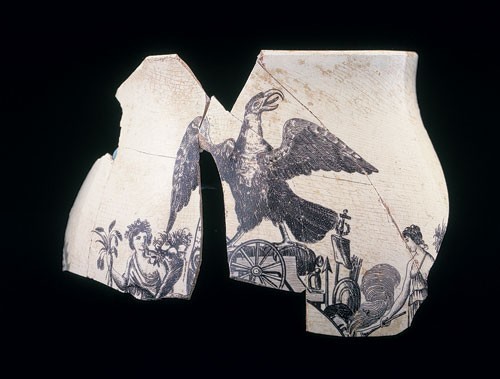
Pitcher fragment, England, ca. 1815. Creamware. These fragments from Arell’s Tavern show the upper portion of a pattern with the spread eagle motif perched atop the cannon. The female figure at right, representing Peace, is torching the tools of war. The figure at left, representing Plenty, holds a sheaf of wheat and a cornucopia. See fig. 27 for the decoration that would appear beneath the cannon. Additional fragments of this pitcher have the names Georgia, Massachusetts, and New Jersey on cartouches beneath the spout.

Pitcher fragment, England, ca. 1815. Creamware. This pitcher base was found in a privy associated with Gadsby’s Tavern. The pattern is similar to the example from Arell’s Tavern illustrated in fig. 26. The slogan “PEACE, PLENTY AND INDEPENDENCE” appears at the bottom. Another fragment of this pitcher, from beneath the spout, shows the American eagle carrying in its beak a ribbon with the motto “E PLURIBUS UNUM.”

Serving dish, attributed to James and Ralph Clews, Staffordshire, ca. 1818–1834. Pearlware L. 12 1/2". The America and Independence series depicts a variety of generic landscapes. This serving dish, recovered from the privy of Gadsby’s Tavern, shows an unidentified castle. The states—New Jersey, Pennsylvania, Maryland, New York, Delaware, Virginia, New Hampshire, Massachusetts, Rhode Island, Connecticut, North Carolina, South Carolina, Georgia, Vermont, and Kentucky—are named in the border. Two figures flank the scenic view, standing on plinths bearing the words “AMERICA AND / INDEPENDENCE.” A blindfolded figure labeled “justice” holds a portrait of Washington. A kneeling figure holds the Liberty Cap.
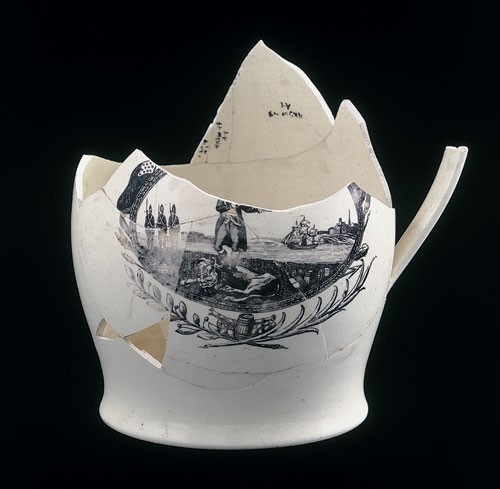
Pitcher fragment, England, ca. 1815. Creamware. This pitcher, found in a privy on a residential site at 414 King Street, commemorates the end of the War of 1812. The transfer print depicts a soldier standing on a lion—representing Britain—and gesturing toward a merchant ship under sail. American flags and weapons of war ornament the cartouche. A hunting scene is on the reverse.

Pitcher, England, ca. 1815. “Cameo jasper” refined stoneware. H. 6". This pitcher has applied relief decoration on a white stoneware body against a dark brown ground. The same pattern is also found on a blue or tan ground. The Great Seal is depicted on one side, and Miss Liberty on the other. Peace is represented by the caduceus and hands clasped in friendship, Plenty by the overflowing cornucopia. This pitcher celebrates the Treaty of Ghent, which was signed on Christmas Day 1814.

Pitcher, attributed to Enoch Wood, Staffordshire, ca. 1815. Creamware with buff-colored ground. H. 6 1/2". On one side appears Rembrandt Peale’s likeness of Captain Jacob Jones, and on the other that of General Zebulon Pike, portraits that were first published in the Analectic Magazine in 1813.
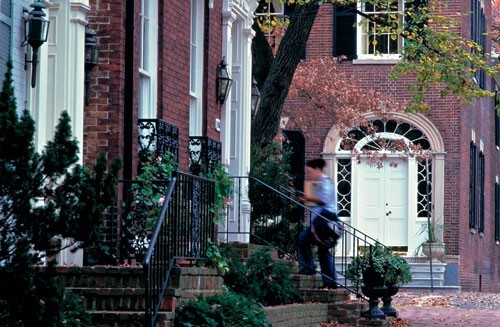
Lafayette House, 301 South St. Asaph Street, Alexandria, Virginia. In October 1824 Mrs. Thomas Lawrason lent her home to Lafayette during his visit to Alexandria. The house continues to be a private residence. (Courtesy, Office of Historic Alexandria; photo, Eric Kvalsvik.)
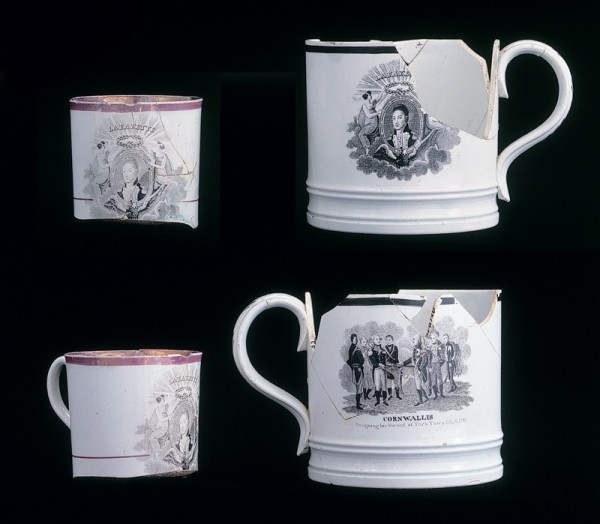
Coffee can and mug, England, ca. 1825. Pearlware. H. of coffee can 2 1/8"; H. of mug 3 1/8". The engraving Lafayette Crowned at Yorktown appears on both vessels. The engraving Cornwallis Resigning His Sword at York Town, Oct. 19, 1781, is on the reverse of the mug.
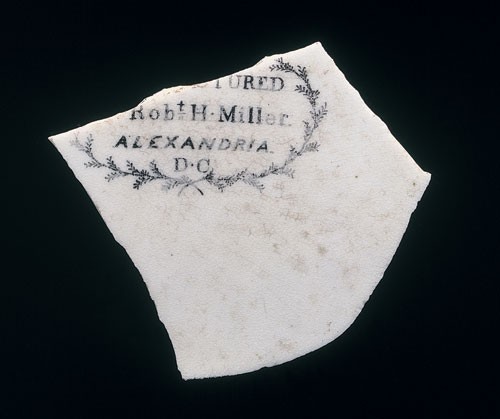
“MANUFACTURED / for Robt H·Miller / ALEXANDRIA. / D·C.” Importer’s mark, England, ca. 1830. Whiteware. Robert H. Miller was one of Alexandria’s most successful businessmen. In 1822 he opened a shop at 317 King Street, on the Market Square, having traveled to England to select the first stock of china and earthenware. Miller’s advertisements in the Alexandria Gazette state that the Lafayette/Cornwallis wares were “executed expressly for him, from a drawing sent out” (July 14, 1825), and that the Harrison campaign wares are from “designs sent out to the Potteries by himself” (September 19, 1840). In fact the designs are stock prints, but he may have selected the prints and vessel forms from a catalog. This mark is from the base of an unknown ceramic vessel that was discarded about 1830 at 418–422 S. Royal Street (44ax30), in the historic free black neighborhood known as Hayti.
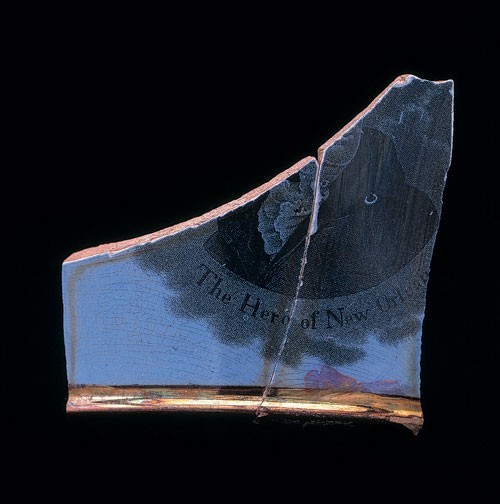
Pitcher fragment, Enoch Wood and Sons, England, ca. 1828. Copper luster, red stoneware body, white slip interior. The Andrew Jackson, Hero of New Orleans motif is usually printed on a canary or blue band, but has also been seen on rust-colored bands. It is also found on a round form, although the slant-sided pitcher is more common. Ellouise Baker Larsen attributes the portrait to J. Wood, engraved by C. G. Childs (Philadelphia, 1828). Copper luster was made from about 1823 to 1845, so such pitchers were intended to celebrate Jackson’s presidential election, long after the Battle of New Orleans.
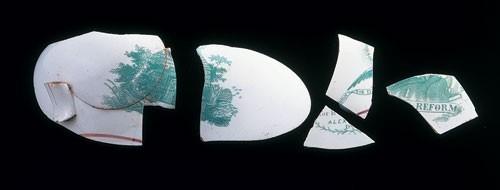
Pitcher sherds, England, 1840. Whiteware. These fragments of a small pitcher, made for Harrison’s “Log Cabin” campaign, were found in a well associated with a doctor’s office (among the other artifacts were tongue depressors, syringes, and eyeglasses). Only a few pieces were found, but they include a portion of the base with part of the mark “Manufactured for Robt H. Miller, Alexandria DC.” The log cabin depicted in the overglaze green transfer print has a sign on it that reads “TO LET IN 1841,” the year Harrison went to the White House. On the reverse is a portrait of Harrison and the motto “HARRISON AND REFORM.” Under the spout is an eagle holding a scroll bearing the motto “UNION FOR THE SAKE OF THE UNION.”
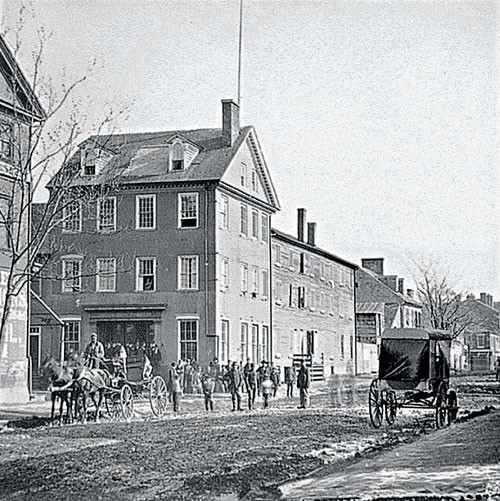
The Marshall House Hotel, King and Pitt Streets, during the Civil War. (Courtesy, Library of Congress, Prints and Photographs Division, lc-b8171-2294 dlc.)

Ellsworth pitcher, attributed to Millington, Astbury and Poulson, Trenton, New Jersey, 1861. Whiteware. H. 9". (Courtesy, The Lyceum: Alexandria’s History Museum.) This famous pitcher memorialized Colonel Elmer Ellsworth, the first Union martyr, who was killed in Alexandria on May 24, 1861. The design is based on a sketch by Corporal (formerly Private) Brownell. The molded design shows the figures of the slain Colonel Ellsworth on the left. Brownell, who avenged Ellsworth’s death by killing Jackson, is shown in the center, with “J. W. JACKSON THE TRAITOR” identified on the stairs. A Union eagle and Confederate serpent are depicted on the reverse, with a South Carolina palmetto supporting the early Confederate flag. The United States flag is supported by rifles.
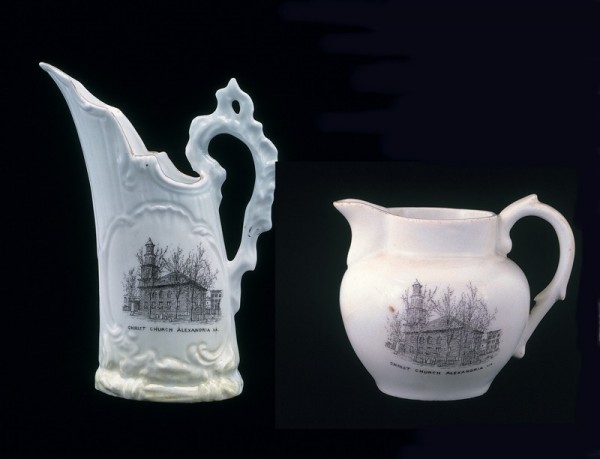
Pitchers, Austria, ca. 1897–1908. Porcelain. Left: H. 6 1/2"; right: H. 3 1/2". (Courtesy, The Lyceum: Alexandria’s History Museum. Gift of Ken Turino.) They differ in shape, but these porcelain pitchers share the illustration of Christ Church, Alexandria, and the marks on the base (see fig. 40). Other scenes of churches and historic sites were made for retailers throughout the country. These pitchers were made for E. J. Miller and Co., at 119 King Street, Alexandria.
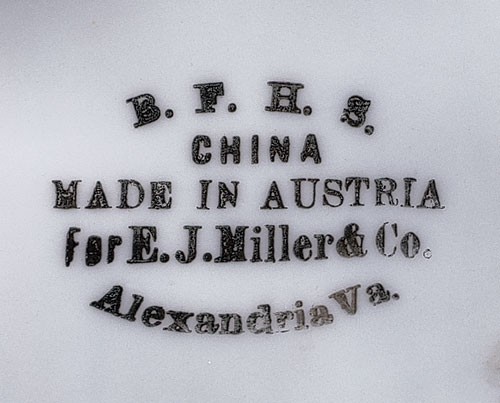
Detail of the mark used on the pitchers illustrated in fig. 39. Benjamin F. Hunt and Sons (B.F.H.S.) was a manufacturer and importer of porcelain from Austria at the turn of the century.
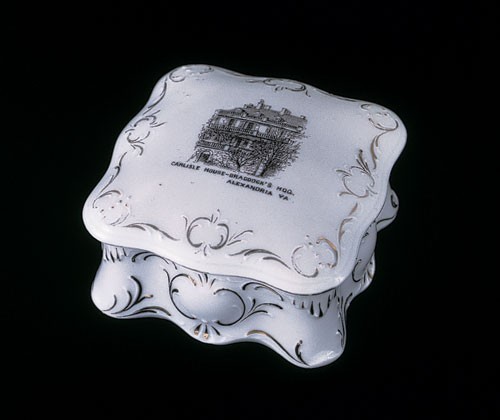
Lidded box, Austria, ca. 1897–1908. Porcelain. W. 4". (Courtesy, Alan Darby.) The box is inscribed “CARLISLE HOUSE—BRADDOCK’S HDQ., ALEXANDRIA VA,” and the markings on the bottom are the same as those illustrated in fig. 40.
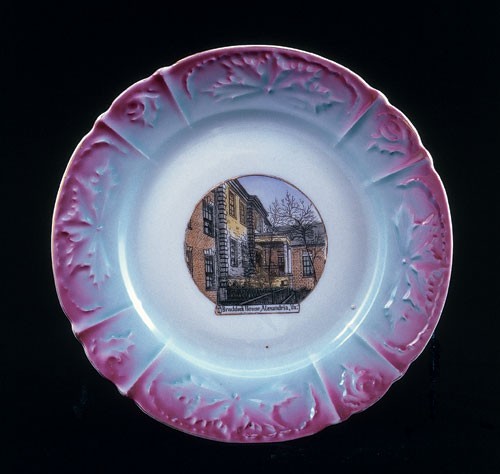
Plate, Germany, early twentieth century. Whiteware. D. 7 5/8". (Courtesy, The Lyceum: Alexandria’s History Museum. Bequest of William R. Adam.) General Braddock headquartered at John Carlyle’s house for three weeks in 1755, during the French and Indian War. This souvenir plate is illustrated with a postcard view of the Carlyle House. For many years the historic mansion was surrounded by a large hotel, which was at one time known as the Braddock House. C. E. Wheelock imported both postcards and china from Germany, and the company marketed plates with local postcard views directly to stores around the country.This plate was made for R. E. Knight in Alexandria. Knight’s Stationery, Toy and Souvenir store opened at 621–625 King Street in 1906. Souvenir china was imported from Germany from about 1890 to 1930.
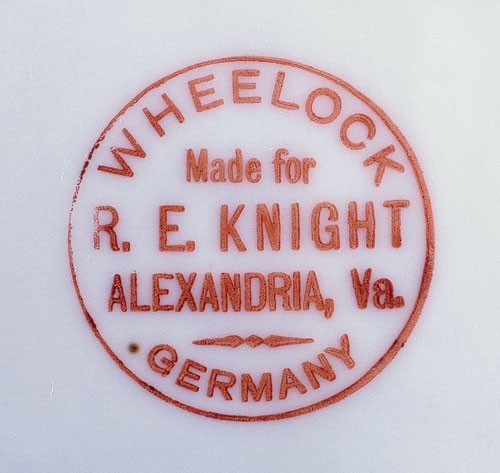
Detail of the mark used on the bottom of the plate illustrated in fig. 42.
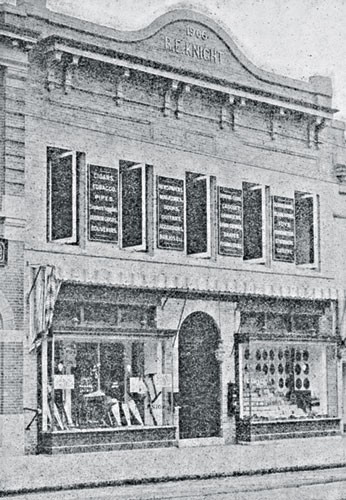
“R. E. Knight’s new Stationery, Toy and Souvenir stores,” 621–625 King Street, 1906. (Courtesy, Alexandria Archaeology Museum.) The store opened in 1906 and was illustrated in a 1907 souvenir booklet. Alexandria Archaeology’s offices were located in this building in the early 1980s.
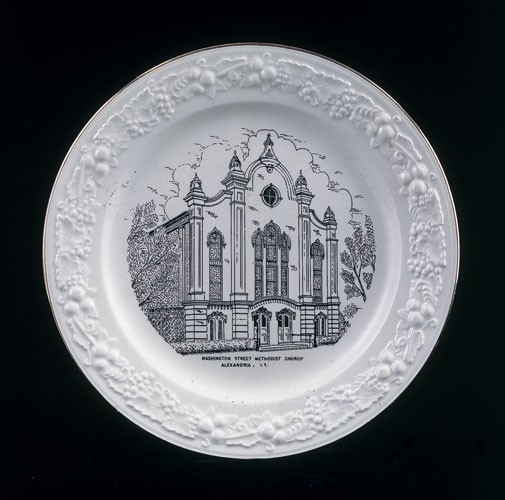
Plate, Homer Laughlin China Company, Newell, West Virginia, 1952. Whiteware. D. 9 3/4". (Courtesy, The Lyceum: Alexandria’s History Museum.) These plates likely were ordered for the centennial of the Washington Street Methodist Church, Alexandria, which was built in 1850–1851, as the numbers and letters in the green-printed maker’s mark date this plate to February 1952.

Detail of the mark used on the bottom of the plate illustrated in fig. 45.

Plate, J. H. Weatherby and Sons, Staffordshire, ca. 1990s. Whiteware. D. 9 7/8". (Courtesy, The Lyceum: Alexandria’s History Museum. Gift of Monta Lee Dakin.) This plate depicts the George Washington Masonic National Memorial in Alexandria, Virginia, which was built between 1922 and 1932. The memorial served as the home for Alexandria Lodge 22, of which George Washington was a member, serving as master from 1788 to 1789.
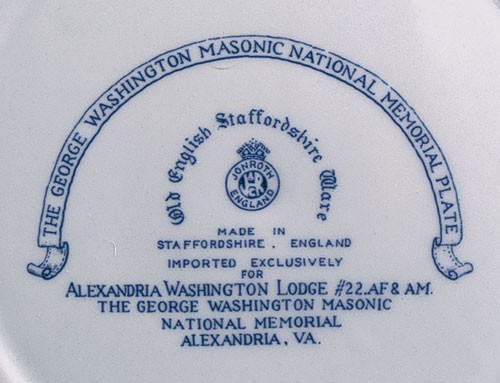
Detail of the mark used on the bottom of the plate illustrated in fig. 47.
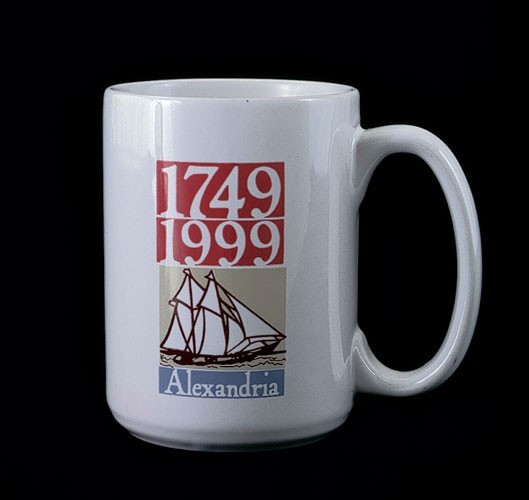
Mug, 1999. Whiteware. H. 3 1/4". This mug was commissioned by the City of Alexandria's 250th Birthday Commission to celebrate the 1999 anniversary of the city's founding. The logo shows a three-masted schooner under sail, honoring the city's maritime history.
